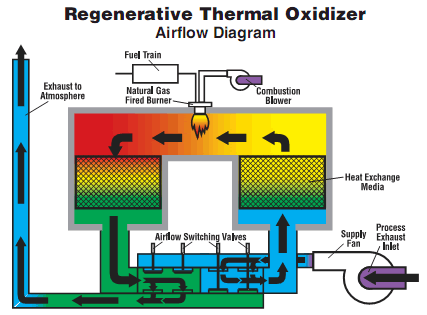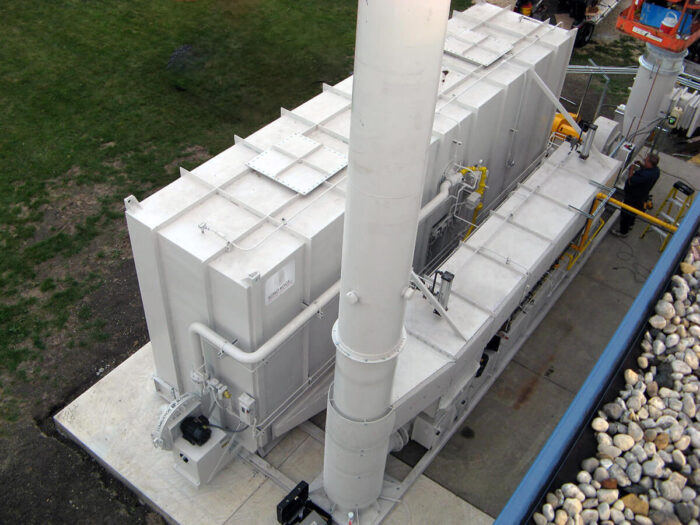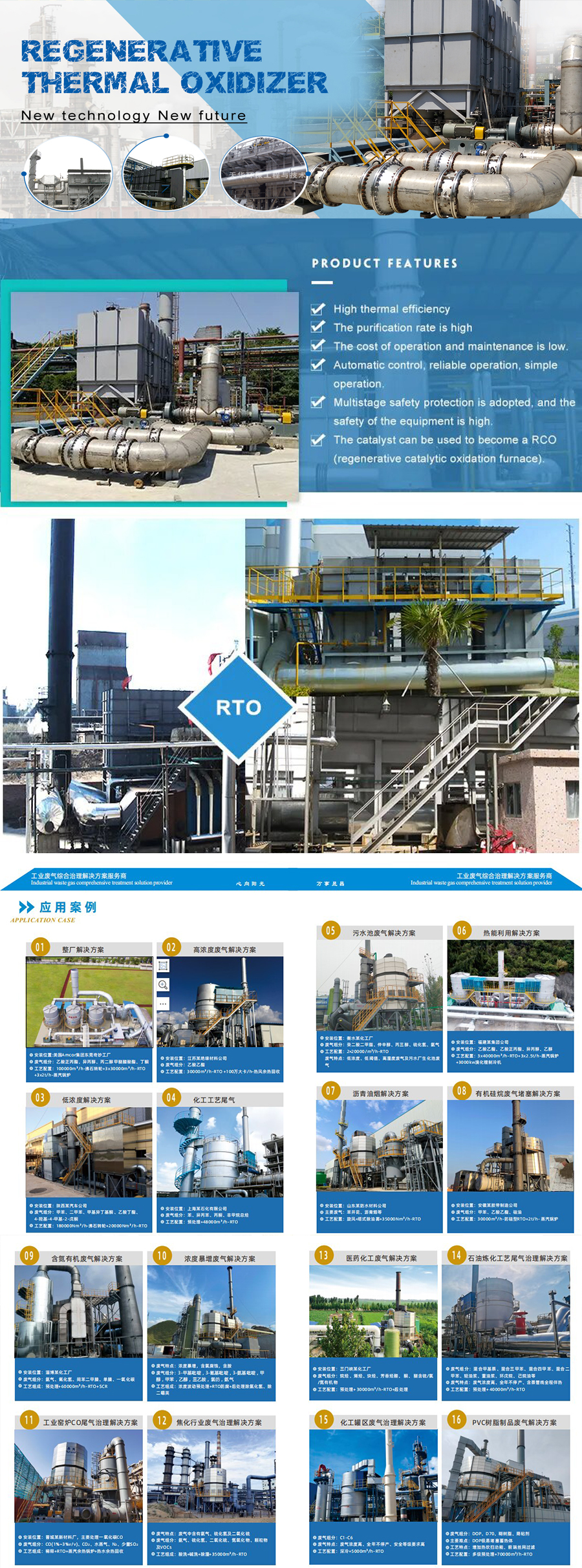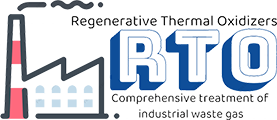基本訊息
型號
RTO
Processing Methods
Combustion
Pullution Sources
Air Pollution Control
商標
RUIMA
起源
China
HS Code
84213990
產品描述
Regenerative Thermal Oxidizer (RTO);
The most widely used oxidation technique nowadays for
VOC emission reduction,; suitable for treating a wide range of solvents and processes.; Depending on air volume and required purification efficiency,; a RTO comes with 2,; 3,; 5 or 10 chambers.;
Advantages
Wide range of VOC’s to be treated
Low maintenance cost
High Thermal Efficiency
Does not generate any waste
Adaptable for small,; medium and large air flows
Heat Recovery via bypass if VOCs concentration exceed the auto-thermal point
Auto-thermal and Heat Recovery:;
Thermal Efficiency > 95%
Auto-thermal point at 1.;2 – 1.;7 mgC/Nm3
Air flow range from 2,; 000 up to 200,; 000m3/h
High VOC’s destruction
The purification efficiency is normally in excess of 99%
Address: No 3 North Xihu (West Lake) Dis. Road, Xihu (West Lake) Dis., HangZhou, ZheJiang , China
Business Type: Manufacturer/Factory
Business Range: Manufacturing & Processing Machinery, Service
Management System Certification: ISO 14001, ISO 9001, OHSAS/ OHSMS 18001, QHSE
Main Products: Dryer, Extruder, Heater, Twin Screw Extruder, Electrochemical Corrosion Protection Equ, Screw, Mixer, Pelletizing Machine, Compressor, Pelletizer
Company Introduction: The Res. Inst of Chem. Mach of the Ministry of Chemical Industry was founded in ZheJiang in 1958, and moved to HangZhou in 1965.
The Res. Inst of Automation of the Ministry of Chemical Industry was founded in HangZhou in 1963.
In 1997, the Res. Inst. Of Chem. Mach of the Ministry of Chemical Industry and the Res. Inst. Of Automation of the Ministry of Chemical Industry were combined to become the Res. Inst of Chemical Machinery and Automation of the Ministry of Chemical Industry.
In 2000, the Res. Inst of Chemical Machinery and Automation of the Ministry of ChemicalIndustry completed its transformation to enterprise and registered as CHINAMFG Instituteof Chemical Machinery and Automation.
Tianhua Institute has the following subordinated institutions:
Supervision and Inspection Center of the Quality of Chemical Equipments in HangZhou, ZheJiang Province
HangZhou Equipment Institute in HangZhou, ZheJiang Province;
Automation Institute in HangZhou, ZheJiang Province;
HangZhou Ruima Chemical Machinery Co Ltd in HangZhou, ZheJiang Province;
HangZhou Ruide Drying Technology Co Ltd in HangZhou, ZheJiang Province;
HangZhouLantai Plastics Machinery Co Ltd in HangZhou, ZheJiang Province;
ZheJiang Airuike Automation Technology Co Ltd in HangZhou, ZheJiang Province;
The HangZhou United Institute of Chemical Machinery and automation and the HangZhou United Institute of Petrochemical Industry Furnaces were founded by CHINAMFG Institute and the Sinopec.
Tianhua Institute has an occupation area of 80 000m2 and a total asset of 1 Yuan (RMB). The annual output value is 1 Yuan (RMB).
Tianhua Institute has about 916 employees, 75% of them are professional personnel. Among them are 23 professors, 249senior engineers, 226 engineers. 29 professors and senior engineers enjoy national special subsidy, On 5 people the title of Middle-aged and Young Specialist with Outstanding Contribution to the P. R. China are conferred

Can regenerative thermal oxidizers be used for treating industrial wastewater?
No, regenerative thermal oxidizers (RTOs) are not typically used for treating industrial wastewater. RTOs are specifically designed for air pollution control and the treatment of gaseous pollutants, such as volatile organic compounds (VOCs) and hazardous air pollutants (HAPs).
Here are some key points to consider regarding the use of RTOs for treating industrial wastewater:
- Operating Principle: RTOs rely on the combustion of pollutants in the gas phase. They utilize high temperatures to thermally oxidize gaseous pollutants, converting them into carbon dioxide and water vapor. However, wastewater treatment involves the removal or transformation of contaminants dissolved or suspended in water, which requires different treatment mechanisms.
- Wastewater Treatment Technologies: Wastewater treatment typically involves processes such as physical separation, chemical treatment, biological treatment, and other specialized techniques depending on the nature of the contaminants. Common wastewater treatment technologies include activated sludge systems, sedimentation tanks, chemical precipitation, filtration, and various other methods tailored to specific wastewater characteristics.
- Environmental Regulations: Industrial wastewater treatment is subject to stringent environmental regulations and discharge standards that govern the quality of effluent released into water bodies. Compliance with these regulations requires the implementation of appropriate wastewater treatment technologies specifically designed for the removal or reduction of contaminants in water, rather than air pollution control technologies like RTOs.
- Integration with Wastewater Treatment Systems: While RTOs are not used for wastewater treatment, they may be integrated into overall industrial process systems where wastewater treatment is also required. In such cases, separate wastewater treatment technologies are employed to treat the wastewater, and RTOs are used to address air emissions resulting from the wastewater treatment process or other industrial operations.
In summary, regenerative thermal oxidizers are not suitable for treating industrial wastewater. They are designed for air pollution control and the destruction of gaseous pollutants. For effective wastewater treatment, industries should employ appropriate wastewater treatment technologies specifically designed for the removal or transformation of contaminants in water.

蓄熱式熱氧化器如何處理系統中顆粒物的堆積?
蓄熱式熱氧化器 (RTO) 採用各種機制來處理系統中顆粒物的堆積。灰塵、煙灰或其他固體顆粒等顆粒物會隨著時間的推移而積累,並可能影響 RTO 的性能和效率。以下是 RTO 處理顆粒物堆積的一些方法:
- 預過濾: RTO 可以採用預過濾系統,例如旋風分離器或袋式過濾器,以在較大的顆粒物質進入氧化器之前將其去除。這些預過濾器捕獲並收集顆粒,防止它們進入 RTO 並減少積聚的可能性。
- 自潔效果: RTO 的設計目的是對熱交換介質具有自清潔作用。在 RTO 運作期間,熱廢氣流過介質會導致顆粒燃燒或分解,從而最大限度地減少顆粒的累積。高溫和湍流有助於保持介質表面清潔,並降低大量顆粒堆積的風險。
- 吹掃週期: RTO 通常將吹掃循環作為其操作的一部分。這些循環涉及將少量清潔空氣或氣體引入系統以清除任何殘留的顆粒物質。吹掃空氣有助於去除或燒掉任何黏附在介質上的顆粒,確保介質的持續清潔。
- 定期維護: 定期維護對於防止 RTO 中顆粒物堆積過多至關重要。維護活動可能包括檢查和清潔熱交換介質,檢查和更換任何磨損的墊圈或密封件,以及監控系統是否有任何顆粒積聚的跡象。定期維護有助於確保最佳性能,並最大限度地降低與顆粒物堆積相關的操作問題的風險。
- 監控與警報: RTO 配備了監控系統,可追蹤壓力差、溫度和流量等各種參數。這些系統可以檢測任何可能表明顆粒物堆積的異常情況或過度壓力降。可以觸發警報和警報來通知操作員,提示他們採取適當的行動,例如啟動維護或清潔程序。
值得注意的是,用於處理顆粒物堆積的具體策略可能會根據 RTO 的設計和配置以及所處理的顆粒物的特性而有所不同。 RTO製造商和營運商應考慮這些因素並採取適當的措施,以確保系統中顆粒物的有效管理。
透過結合預過濾、利用自清潔效應、實施吹掃循環、進行定期維護以及採用監控系統,RTO 可以有效處理和減少顆粒物積聚,從而長期保持其性能和效率。

What are the advantages of employing a regenerative thermal oxidizer?
Invented to aid enterprises control the toxic emissions produced during multiple distinct sorts of operations, a regenerative thermal oxidizer (RTO) is a modern pollution control technology. It targets other dangerous pollutants, hazardous air pollutants (HAPs), and volatile organic compounds (VOCs) rather successfully.
The key benefits of using a China RTO in industrial operations are numerous and impactful:
1. Exceptional Pollutant Removal
The China RTO stands out for its high-efficiency pollutant destruction capabilities. With destruction rates often exceeding 99%, these systems ensure that VOCs and HAPs are effectively eliminated. This results in cleaner emissions, helping companies stay in line with strict environmental regulations and contributing to improved air quality.
2. Power Efficiency Through Heat Recovery
One of the standout elements of a regenerative thermal oxidizer is its energy-saving structure. China RTOs utilize a regenerative approach to capture and reuse the heat from exhaust gases. This lets the system preheat incoming air, decreasing the necessity for additional fuel and lowering overall energy consumption. As an outcome, businesses profit from decreased operating expenses and a more undersized environmental footprint.
3. Long-Term Financial Advantages
China RTOs’ energy efficiency clearly results in large financial savings. These approaches provide businesses with a reasonably affordable alternative by reducing the need for outside fuel sources and cutting the running expenses related to pollution management. Furthermore, businesses can avoid funding further pollution control equipment by using their great destruction efficiency, therefore reducing capital and maintenance costs.
4. Self-Sustaining Thermal Operations
A key feature of China RTOs is their ability to operate without constant reliance on external fuel. Once the system reaches its operating temperature, the heat recovery process ensures that the thermal energy needed for oxidation is maintained. This self-sustaining nature minimizes the need for external fuel inputs, improving the overall reliability and efficiency of the system.
5. Adaptability to Various Industrial Needs
China’s RTOs are extremely adaptable and can accommodate a diverse array of exhaust volumes, pollutant types, and concentrations. These systems can be designed to fit the particular needs of many industrial uses regardless of changing flow rates, heavy pollution loads, or various intake temperatures. This adaptability guarantees the best performance in many surroundings.
6. Minimal Maintenance Requirements
Another advantage of China RTOs is their low maintenance needs. Thanks to the potent design and regenerative approach, these systems need less maintenance compared to other pollution control solutions. Frequent assessments, preventative upkeep, and infrequent inspections are normally enough to keep the system operating smoothly, minimizing downtime and keeping operational costs low.
7. Environmental Compliance and Responsibility
With their capability to efficiently terminate toxic emissions, China RTOs allow industries to meet rigid environmental measures. By ensuring that VOCs and HAPs are lowered to permissible levels, these procedures play a critical part in regulatory adherence, protecting both the atmosphere and the health of local communities.
China RTOs propose an exhaustive solution for industries looking to improve their environmental sustainability while upholding operational efficiency. Their high pollutant removal rates, energy efficiency, cost savings, and adaptability make them an ideal choice for businesses devoted to lessening their environmental consequence and attaining long-term success.

editor by CX 2024-04-04
